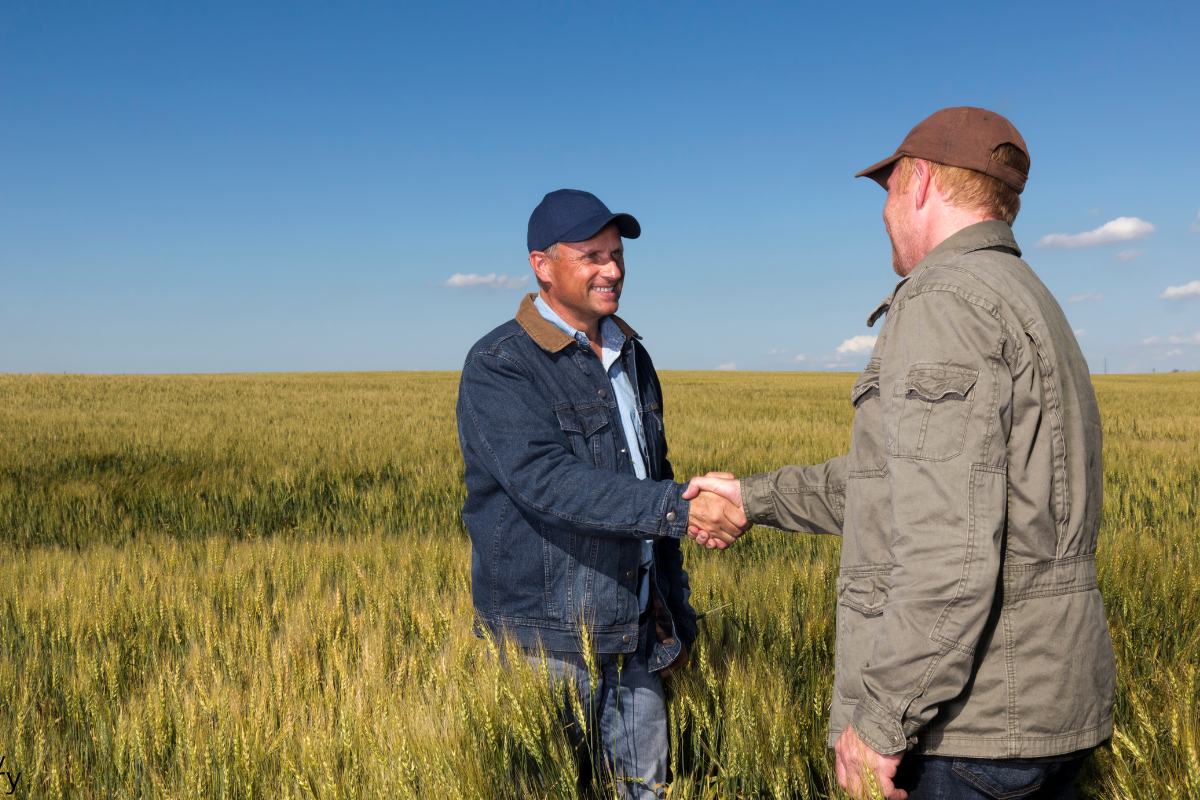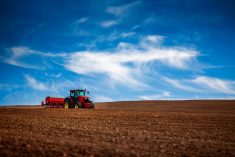Her words were carefully chosen to avoid any sense of panic, and she delivered them in a flat, bureaucratic monotone. But on October 18, 2010, when U.S. Federal Deposit Insurance Corporation chair Sheila Bair warned that the rapidly rising farmland values may be the next asset bubble, she actually didn’t have to worry.
Farmers and investors may have heard her words, but they didn’t get the message. At least, they certainly haven’t acted on it.
In a speech to the Risk Management Association in Baltimore, Bair shared her thinking. “Over the past dozen years or so, the United States has experienced classic asset price bubbles in the stock market and the housing market,” she said. “Where might asset bubbles be forming today?”
Read Also

Are you ready for farm succession?
What motivates some farmers to make a succession plan while others don’t seem worried.
“One candidate is U.S. farmland values,” she said. Bair pointed to statistics showing that even after inflation is taken out of the equation, American land prices are still some 58 per cent above their 2000 levels.
“Today’s positive fundamentals are subject to change,” Bair said. “A sharp decline in farmland prices similar to the early 1980s could have a severe adverse impact on the country’s 1,579 farm banks.”
They are on the front line, and while the credit structure underlying U.S. farmland doesn’t appear on the face of it to involve the same kind of excess leverage and bad loans that toppled the housing market, Bair said the potential for an implosion in the U.S. ag sector is worrisome enough “to require close monitoring.”
Not only do the same warnings hold north of border, some experts think the risks here are even worse.
George Brinkman, retired University of Guelph economics professor and chair of the Statistics Canada Advisory Committee on Agriculture, has a dire warning for Canadian farmers.
“Canadian farmers are four to eight times more vulnerable to a collapse of land prices than U.S. farmers,” Brinkman says. “Farmland prices in Canada are running at a very close parallel to the U.S. housing prices before they collapsed.”
“Agriculture simply cannot sustain the prices farmers are paying for land,” Brinkman says.
Brinkman urges farmers to consider land as an asset that should be looked at no differently than buying stocks in a company. That makes the price-to-earnings ratios (P/E ratio) a key tool for evaluating asset prices.
Since the introduction of the stock market in the 1800s, the average P/E ratio for all stocks has been 15 to 1. Today, most investment strategists avoid stocks when the P/E ratio exceeds 16 to 1.
Yet Brinkman points out that the current agricultural land P/E ratio in much of Canada is way, way beyond that 16-to-1 limit.
Other experts disagree, but it’s possible to look at cash rental as the true earning from land ownership. It’s controversial, but if rent for land in an area is $50 per acre, a 16-to-1 P/E suggests the price level at which investors should start to become wary of purchasing land would be $900 per acre.
Across Canada, there appears to be very little agricultural land that can be purchased for less than 16 times its rental value.
Of course, farmers think about more than its productive value when they buy land. They also think about its investment value, because land is considered a safe hedge against inflation and an appreciating capital asset.
Indeed, when these factors are also taken into consideration, agriculture land that exceeds its pro- ductive value may not be overvalued, says Gary Schnitkey, agricultural economist at the University of Illinois, who suggests land should be evaluated on the basis of its capitalized value.
Capitalized value reflects the earnings of the asset adjusted by long-term interest rates. To arrive at land’s capitalized value, the fair market rental rate of the land is divided by the interest rate available on a 10-year treasury note. As an example, Schnitkey points to the average cash rent in Illinois in 2010, which was $169 per acre. A 10-year treasury note returned 3.33 per cent in the U.S. last year. So the capitalized value of land was $169 divided by 0.0333, which works out to $5,073.
The average selling price of agricultural land in Illinois last year was $4,820. Based on capitalized value, Schnitkey concludes that agricultural land in Illinois isn’t currently overvalued and he downplays the idea that a bubble is forming.
A Canadian example using Alberta land values and Canadian treasury note rates shows the capitalized value of farm land that rented for $50 per acre at the end of 2010 would be calculated as $50 divided by 0.035, or $1,428.57 per acre.
Schnitkey takes these calculations one step further and compares average land prices with their capitalized value over the last 35 years. By charting land rents, land prices, and capitalized values it is easy to see the land value bubble that formed and burst in the early 1980s.
The chart also shows there is a time lag between the capitalized value and the adjustment of actual land prices. This is due to the fact not all cash rents are renewed each year. Many rents are multi-year agreements and so farmers tend to be locked into rents which may not reflect current economic conditions. (See Figure 1.)
Since the capitalized value is determined using rental rates and interest rates, Schnitkey points out a change in either rental rates or interest rates will change the capitalized value. More importantly, it does not take a large change in either factor to significantly impact the capitalized value of land.
Why interest rates change everything
A jump in interest rates from 3.33 in 2010 to 4.33 per cent in 2011 would chop the capitalized value of Illinois land by $961 an acre, Schnitkey says.
The impact such a relatively small rise in interest rates would be massive, yet given the U.S. economic uncertainty, such a rise is far from unthinkable. In fact, some economists predict that much larger increases are ahead.
So, will rising interest burst agriculture’s bubble? The answer is… it depends.
The risk of land prices actually falling because of interest rates rising becomes exponentially greater if the land purchases are being made with debt financing rather than cash.
If land has been purchased with cash, owners may choose to ride out a period of falling land prices before selling. However, if land was purchased with debt financing, buyers may find they no longer have the cash flow to meet land payments due to the higher interest rates, and they may be forced to sell some land, further driving down the market value.
Schnitkey says many U.S. farmers learned a lesson from the 1980s land-price crash when a lot of the land was mortgaged. Today, he says, the debt load on land owned by U.S. farmers is relatively low.
It’s a much different picture in Canada, according to Brinkman. “The amount of farm debt is going up much more rapidly in Canada than in the U.S.,” he points out. “Canadian farmers are carrying 16 to 17 times as much debt as their American counterparts, so Canadian farmers are much more vulnerable to rising interest rates.”
Brinkman believes many Canadian farmers and financial institutions are setting up loans in excess of cash flow. Farmers are living on the current low interest rates. “If interest rates go up even a small amount farmers may not be able to pay off their loans,” Brinkman says.
“A three to four per cent rise in interest rates, as happened in the early 1980s, would cause serious problems to the agricultural sector and start forcing land onto the market causing land prices to crash,” Brinkman says. “Interest rates are the real trigger for land value collapse.”
Rising demand
Lee Egerstrom, a research economist with Minnesota 2020, a non-partisan think tank, believes current land values are a reflection of the dynamic demand for corn by the ethanol market, and while he agrees there is a definite risk of interest rate hikes, given that U.S. financial institutions are not yet stable, he is even more concerned that land prices will fall because of falling commodity prices.
“Much of the value of land is due to the demand for corn by the ethanol industry,” Egerstrom says. “Corn is the driver of land prices. However, the U.S. public and policy-makers are losing their appetite for the ethanol and the corn subsidies needed by the industry to compete with fossil fuels.”
As long as this new demand for corn keeps firm, land prices will stay strong, Egerstrom says. “But if subsidies are ended, we will see a big backing off of land prices.”
Some argue that the biggest factor driving farmland prices these days isn’t even agriculture. Like the land boom of the late 70s, non-farm investors are flocking to the safety and perceived opportunities in land ownership. The past year has seen a host influential names including Jim Rodgers, George Soros, Black Rock, and even Fortune magazine advocating investment in land.
In October, the Wall Street Journal reported the pension industry was looking to move $1 trillion dollars out of the stock market and into less risky investments. Farmland is one such apparently safe investment. Already there are a number of hedge and investment funds actively buying farmland. Even U.S. investment banks have reportedly been purchasing farmland.
Steven Johnson, a partner in the Calgary-based farmland investment fund Agcapita, still thinks farmland in Western Canada is a great investment opportunity. “Saskatchewan farmland is the cheapest in the world,” Johnson says. “It’s easy to justify today’s land prices with the current commodity prices.”
“A bubble is when the price of an asset is irrational,” Johnson says.” One test of irrational pricing is to see if the asset can justify the price by having enough cash flow to be sustainable. If commodities are in a bull market, then the current land prices are not a problem.”
Another reason Johnson believes in the investment opportunity in Saskatchewan farmland is the low cost of production there compared to other agricultural areas, thanks largely to the productivity of the land and an agricultural infrastructure that lets farmers farm with world-class efficiency.
Plus, Johnson says, “farmland is a very cheap inflation hedge. Investors are looking for a safe investment and are becoming hesitant to invest in gold given the current price of gold.”
“Farming may be a very volatile business,” says Johnson. “But farmland ownership is not volatile.”
Keep an eye on rental rates
Not everyone in the investment community agrees with Johnson’s bullish analysis. Even the Wall Street Journal ran an editorial in December questioning the wisdom of investing in land at this time. The editorial board wonders if land values have been artificially inflated by a monetary policy which has driven money out of riskier investments and into the purchase of farmland.
Perhaps the most worrisome indicator that land values could be forming a bubble is the fact rental rates aren’t keeping pace with the rising farmland values.
Schnitkey compared the increase in land prices with increases in rental rates in Illinois and found land prices increased faster than rental rates from 1987 to 2005. During that time, cash rents climbed an average two per cent per year. However, in the same time period farm land prices more than doubled that rate, going up 4.8 per cent per year. (See Figure 2.) USDA figures show that average U.S. farmland rents have decreased from a nation-wide average of 4.96 per cent of farmland value in 1998 to just 3.15 per cent in 2008.
“Declining rents as a percent of price may indicate concern for future farmland price increases,” Schnitkey wrote in his Oct. 18, 2010 paper “Farmland Price Outlook.” In essence, the return on which farmland price is based is becoming a less of a percent of farmland price. “Overall,” he says, “this would be expected to negatively impact farmland prices sometime in the future.”
It’s worrying too that this same disconnect between asset price and earning rates was identified a factor in both the housing and the high-tech bubble.
What we don’t know…
It’s easy to predict that a single factor such as falling commodity prices or rising interest rates will lead to falling land values. Indeed, it’s just as easy for investors to say the new demand for corn for ethanol means fundamentals in agriculture have changed and that we therefore won’t see a land price drop.
The real world is more complicated.
There are a host of factors however that could also influence the price of land. None of these factors work in isolation, and often they’re poorly understood. Even so, anyone who is making a long-term investment in agriculture (or anyone who is considering when to sell) needs to also look at:
Rising fuel costs. While rising fuel costs support the price of corn, they also increase the price of agricultural inputs. Higher costs increase production costs and also increase the debt load that growers carry. As well, they inject more volatility into commodity markets, which all add up to increased financial risk for the grower and which can even lead to changes in productivity as adjustments are made to amount of inputs applied.
Global food demand. Rising world population seems to indicate greater demand for agricultural production. However, the impact of this is uncertain. The areas of the world with rising population rates tend to be the poorest countries which are already short of food. More mouths to feed does not mean more dollars available to buy food.
New competitors. While it is true we have a fixed land base and no more land is being created, there are vast areas of the world which aren’t producing to their potential. Russia has gone from being a net importer of grain to an exporter in less than a generation. Vast areas of rainforest have been and are being converted to food production. There is a land rush in Africa as dramatic as the 1800 gold rush, as individual farmers, investors, corporate entities, and even countries goggle up agricultural land. And the most important thing to note is production in these new frontiers is often done at a cost much lower than that of the intensive agriculture now being practised in North America and Europe. Land and labour costs in these areas are a fraction of the cost here, making this new production more competitive in world markets than current production.
Political support. Ethanol may be the driver of corn prices, but its health depends as much or more on subsidies and politically mandated targets than on actual consumer demand. If fiscal policy or political will changes we could see demand for ethanol, and therefore corn, diminish significantly. Even falling fuel prices could trigger the same event. We have already seen the failure of many ethanol production facilities due to high corn prices, low margins, and inherent problems with ethanol such as transportation.
Bigger and bigger yields. Did the high commodity prices of 2007-08 and in 2010 really indicate new demand and thus new fundamentals, or were the high prices actually a result of production problems and speculation? The commodity price drop in 2008-09 shows us how quickly production can be ramped up and demand satisfied. This shows us bull markets can be driven as much by production shortfalls as growing demand.
So, what will happen next?
No one knows with certainty what land prices will do. In fact, when people start believing that the predictions they’re hearing are fact and not just educated guessing, that’s when bubbles and crashes occur.
The general opinion of everyone, from farmers to investors and the man on the street in the late ’70s and early ’80s was that buying farmland was a guaranteed win. There was the same attitude at the turn of the century when people thought they could not lose investing in the Internet craze. And the world economy is still hurting from the recent belief that housing prices would forever increase and a housing crash was impossible.
Is the rapid run-up in land prices since 2000 the next pitfall for unwary investors?
Brinkman is worried that the answer is yes, and that when the farmland bubble bursts, it will bring intense financial hardship to farmers unless they take actions now.
“We still have time to prevent the failure of farm operations if land prices do crash,” Brinkman says. “Now is the time for farmers to make their farms stronger rather than just bigger. Lock in loans at the current low interest rates. Make sure you have the cash flow to cover your debt obligations if there is a four to five per cent interest rate increase. And, if necessary, consider even selling some land at the current high prices to pay down debt.”
Is Brinkman right? No one knows for sure. But a lot of farmers will be watching land rents this winter. If a bubble occurs when the income from rent no longer justifies the price of the land, the economists we talked to on both sides of the border say we’ve got some thinking to do.CG
———
“ Now is the time for farmers to make their farms stronger rather than just bigger.” — George Brinkman
———
“ Farming may be a very volatile business, but farmland ownership is not”
— Stephen Johnson















